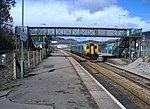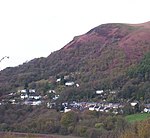Taff's Well Thermal Spring

Taff's Well thermal spring is located in Taff's Well (Welsh: Ffynnon Taf) north of Cardiff, South Wales, UK (National Grid Reference ST 11925 83639) and an elevation of about 30 m. It is the only thermal spring in Wales. The spring emerges on the eastern bank of the River Taff and has been contained within a brick well structure and building. Access is via Taff's Well park, a public park, owned and maintained by Rhondda Cynon Taff Council. The spring is enclosed inside a well and stone building constructed in the 19th century. The well built to contain the spring waters is brick lined and approximately 4 m deep. The building has an internal dimension of 5.3 × 3.9 m, and water fills this area. A brick built spiral staircase is incorporated in the inside of the well. There is one visible overflow pipe which emerges several meters to the west of the spring, on the bank of the River Taff. A recent conceptual model considers that the water has journeyed from the limestone outcrops on the north crop of the coalfield over a period of at least five thousand years, but possibly ten thousand. The site is not protected by any statutory legislation; it is however, a registered "Regionally Important Geological Site" or RIGS and a Grade II listed building site
Excerpt from the Wikipedia article Taff's Well Thermal Spring (License: CC BY-SA 3.0, Authors, Images).Taff's Well Thermal Spring
Park Lane,
Geographical coordinates (GPS) Address Nearby Places Show on map
Geographical coordinates (GPS)
| Latitude | Longitude |
|---|---|
| N 51.544748 ° | E -3.271488 ° |
Address
The Taff's Well
Park Lane
CF15 7PF , Taffs Well
Wales, United Kingdom
Open on Google Maps






